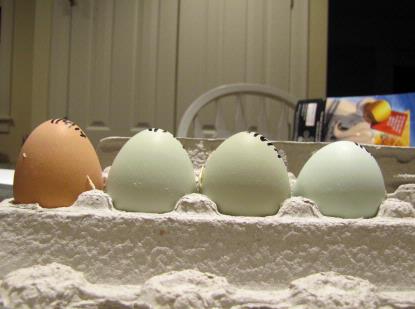Back in November an interloper showed up in our neighborhood. She was in the middle of a molt and didn’t look healthy at all. After posting “found chicken” notes on the local list serves a few times, I decided to keep her. She filled out nicely over the next few months.
Then in mid-December I was fussing about in the garage and heard some aggressive pecking. I threw open the door: there she stood, yolk dripping from her beak and a broken egg at her feet. An egg eater! In humans this is a fine trait, but in many jurisdictions it’s a capital offense for chickens (along with “I’m hungry” and “you look tasty”). There has been no ruling in my yard, but I suspected that at the least it would mean penal transportation.
It remained possible that the egg-eating was some sort of youthful indiscretion. Perhaps the egg was already broken and she just happened upon it. I monitored the situation, but found no more egg-eating.
Then I found a blue egg in the coop, oh ickle Henrietta I never suspected you of anything, it was just a misunderstanding.
My ladies have taken a long time to recover from this November’s molt. But Henrietta has been a trooper, she lays a lovely blue egg every other day. Perhaps “trooper” is wrong as it suggests a soldier and laying eggs is not part of the standard operating procedure in the military. Though I’m sure they’d try if ordered.

Bird eggs come in many colors, though the adaptive significance of speckling and colors is unclear. To paraphrase a recent article in PLoS One, “we have no freaking idea why eggs are different colors” (Wragg et al PLoS One, 2013).
What these pointy-heads and another group (Wang et al PLoS Genetics, 2013) have figured out is the biochemical reason some hens lay blue-green eggs.
This is a bit weird. The trait is caused by what’s called an “endogenous retrovirus.” The blue comes from a chemical called biliverdin, a break down product of hemoglobin (the red color in blood). Biliverdin is what makes bruises blue, it in turn breaks down to bilirubin which is yellow (as in jaundice and the edges of bruises). Biliverdin isn’t supposed to be in egg shells but at some point an historical chicken got a virus that infected its germ line cells (sperm or eggs). The viral DNA was inserted into the chicken DNA near the gene that imports biliverdin into cells. Because this was in the sperm or egg it got passed on to the chicken’s offspring.
The retrovirus doesn’t make the chicken sick (at least anymore), but it turns on the biliverdin import gene in the wrong place: in the shell gland and oviduct of the hen. So blood breakdown products are imported into the egg shell to give it that pretty blue color.
This leaves us with some questions though: would Ted Cruz eat blue-green eggs with ham? Would he do it if he knew that the color came from the genetic echo of a retrovirus from Chili? Does the retrovirus have a green card?


